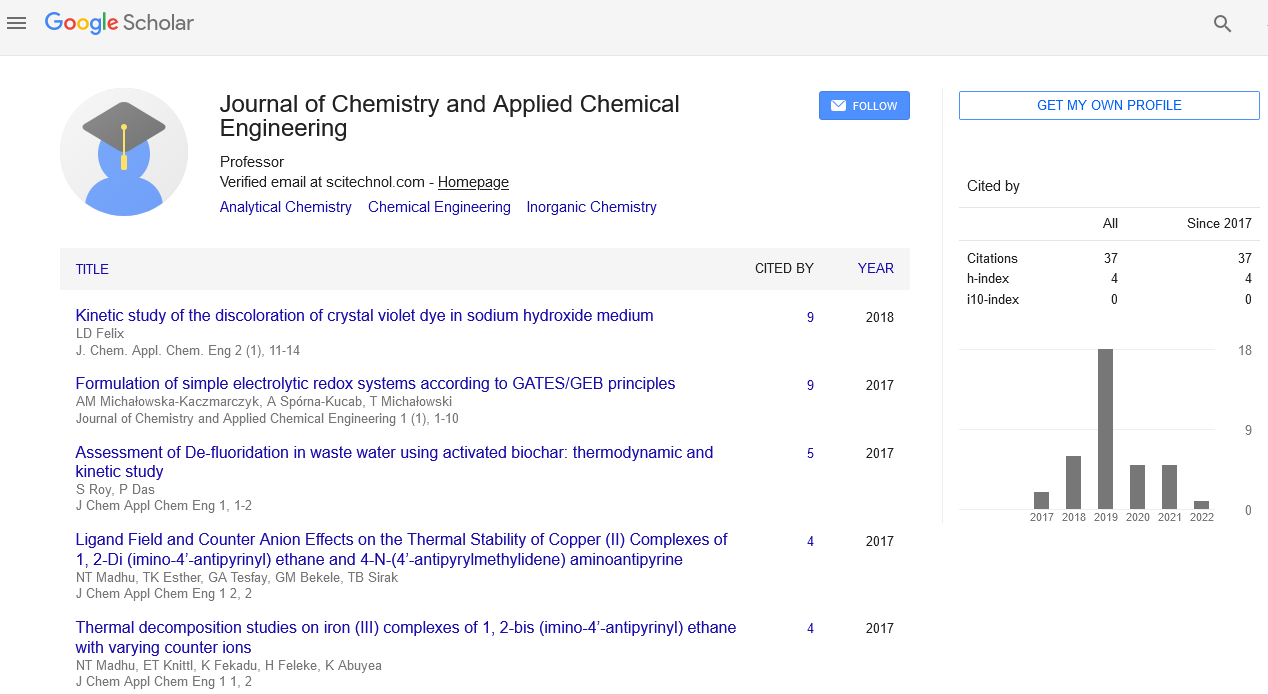Opinion Article, J Chem Appl Chem Eng Vol: 7 Issue: 1
Electrochemical Reduction of CO2 to Value-Added Chemicals and Fuels
Shakiba Taylor*
1Department of Materials Science and Engineering, University of Maryland, Maryland, USA
*Corresponding Author: Shakiba Taylor
Department of Materials Science and
Engineering, University of Maryland, Maryland, 20740, USA
E-mail: tyshakiba@umd.edu
Received date: 28 February, 2023, Manuscript No. JCACE-23-95544;
Editor assigned date: 03 March, 2023, Pre QC No. JCACE23-95544(PQ);
Reviewed date: 17 March, 2023, QC No. JCACE-23-95544;
Revised date: 24 March, 2023, Manuscript No. JCACE-23-95544(R);
Published date: 31 March, 2023, DOI: 10.4172/Jcace.1000e017
Citation: Taylor S (2023) Electrochemical Reduction of CO2 to Value-Added Chemicals and Fuels. J Chem Appl Chem Eng 7:1.
Description
Electrochemical Reduction of CO2 (ERC) is a potential approach to mitigate greenhouse gas emissions while producing value-added chemicals and fuels. The ERC process involves the reduction of CO2 using electricity generated from renewable sources, such as solar or wind, to produce high-value products, such as formic acid, methane, methanol, and ethylene. In this process, the CO2 is converted into reduced species using a suitable catalyst and electrochemical cell.
CO2 reduction and product formation. During the CO2 reduction step, CO2 molecules are electrochemically reduced to CO, HCOO-, H2, or CH4. These reduced species then react with protons or other intermediates to form high-value chemicals and fuels. The product formation step is highly dependent on the catalysts used in the process. Catalysts are essential in facilitating the reaction between the reduced species and protons or other intermediates to form desired products.
One of the significant advantages of the ERC process is its potential to produce chemicals and fuels with high selectivity and efficiency. The selectivity of ERC reactions depends on the catalyst used, the electrochemical cell configuration, and the operating conditions. For example, copper-based catalysts have shown high selectivity for the formation of ethylene, while silver-based catalysts have been found to be highly selective for the formation of methanol. Platinum-based catalysts are also known to produce formic acid with high selectivity.
The ERC process also has a significant advantage over conventional processes that rely on fossil fuels as the source of carbon. ERC utilizes CO2 from the atmosphere or industrial emissions, making it a sustainable and environmentally friendly technology. Moreover, ERC can produce chemicals and fuels with lower carbon footprints compared to conventional processes. This is because the CO2 used in the ERC process is a greenhouse gas, and its conversion into valuable chemicals and fuels represents a net reduction in CO2 emissions.
Despite the advantages of the ERC process, there are still challenges that need to be addressed. One of the primary challenges is improving the efficiency of the process. The ERC process is energyintensive, and the energy requirements for the process can be high, making it challenging to achieve economic viability. To overcome this challenge, researchers are discussing ways to improve the efficiency of the electrochemical cell and the catalysts used in the process. For example, using nanomaterials as catalysts can increase the efficiency of the process by increasing the active surface area of the catalysts.
Another challenge of the ERC process is the stability of the catalysts used in the process. Most catalysts are susceptible to degradation over time due to the harsh conditions of the process, such as high temperatures and corrosive environments. Developing stable and long-lasting catalysts is essential to ensure the sustainability of the ERC process.
Electrochemical reduction of CO2 to value-added chemicals and fuels is a potential approach to mitigate greenhouse gas emissions while producing valuable products. ERC has the potential to produce chemicals and fuels with high selectivity and efficiency while utilizing CO2 from the atmosphere or industrial emissions. However, challenges such as improving the efficiency of the process and developing stable catalysts need to be addressed to ensure the sustainability of the ERC process.
 Spanish
Spanish  Chinese
Chinese  Russian
Russian  German
German  French
French  Japanese
Japanese  Portuguese
Portuguese  Hindi
Hindi 